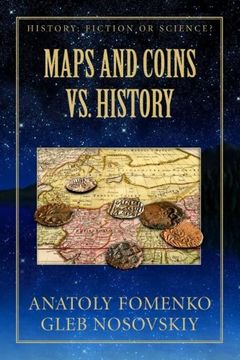Reseña del libro "Maps and Coins vs History: Volume 17 (History: Fiction or Science? ) (en Inglés)"
Maps & coins point to the Empire of Eurasia. The accumulation of geographical knowledge as reflected in cartography is a gradual and irreversible process. Therefore the more details are contained in a map the more recent it is. Most of allegedly 'ancient' maps were produced in the XVI-XVIII centuries because they contain the details unknown at the moment of their presumed composition. Their age is 'alleged' too. Moreover, all maps with the irrefutable date of the composition prior to the XIII century show the picture in complete contradiction with consensual history. Before the advent of engraving and printing, any map was more a unique work of art than a reliable geographical instrument for land or maritime orientation. It is assumed that in some cases certain archaeological findings can be dated with the aid of the ancient coinage found on the site. However, one should be aware that the so-called numismatic dating as used today is wholly dependent on consensual chronology elaborated by Kabbalist Scaliger and perfected by Jesuit Petavius. The ancient coins were distributed along the time axis - for instance, coins bearing the legend "Nero" were dated to the first Scaligerian century a.d., the ones saying "Justinian," to the sixth Scaligerian century a.d., etc., since those are the centuries where Scaligerian chronology locates the Roman emperors Nero and Justinian. After that, all of the coins found in the XVII-XX century have either been dated by the same "method," or compared to the ones that have already received datings, and are placed on the time axis accordingly. It is perfectly obvious that in the case of any alteration of the Scaligerian chronology this "method" is based upon, it shall automatically alter the "numismatic datings" as well. Furthermore, independent comparison of different coins that isn't based on external chronological considerations, cannot even tell us anything about the relative chronology of the coins under comparison, let alone their absolute chronology. Comparing actual coins as metallic objects bearing graphical designs of some sort cannot give us exact knowledge of which coin is older and which is newer. The analysis of the metal that the actual coin is made of can point at its geographical point of origin in some cases. However, the calculation of the date - absolute or relative - sadly remains an impossibility. Who, Why, and When invented Antiquity and Dark Ages in Europe? The consensual world history was manufactured in Europe in XVI-XIX centuries on the political agenda of powers of that period on the basis of erroneous clerical chronology elaborated by Jesuits Joseph Justus Scaliger and Dionysius Petavius.- By the middle of XVI century the prime political agenda of Europe that reached superiority in Sciences and Technologies, but was still inferior militarily to the Evil Empire of Eurasia, was to free Europe.-The concerted effort of European aristocracy, black and white Catholic clergy, Protestants, humanists and scientists in the XV - XVII centuries in creation and dissemination of fictional Ancient World served this agenda.- The fictional Ancient World was created by representing events of XI-XVI centuries as ones that happened thousands of years before according to the ancient sources they wrote by authorities they invented.- The European aristocracy, a considerable part of which were fugitives from Byzantine and/or the inheritors of Eurasian warlords, supported the myth of Ancient World to justify its claims to countries they ruled.- The black and white Catholic clergy, Protestants developed and supported the myth of Ancient World to justify their claims of being more ancient and to separate themselves from Eurasian orthodoxy in the countries ruled by European aristocracy.- The scientists supported the myth of the Ancient World as safe cover for their heretic research that produced results contrarian to the tenets of Christianity. https: //evilempire.blog/

